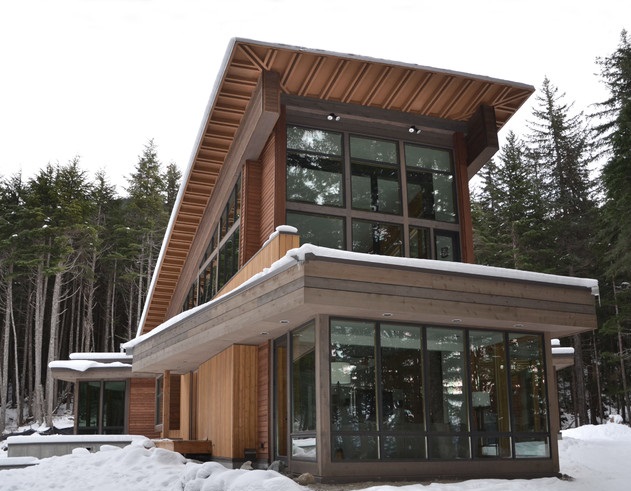Introduction
Building a home in Alaska is a unique challenge due to the state’s extreme weather conditions. From icy winters to the potential for earthquakes, Alaska demands homes that can withstand the harshest elements. This necessity has driven innovation in weather-resistant home designs, making Alaska a fascinating case study in the real estate market. In this blog post, we will explore various aspects of building weather-resistant homes in Alaska, offering insights into design strategies, materials, and the broader real estate implications.
Understanding Alaska’s Climate Challenges
Alaska’s climate is notoriously severe, characterized by long, frigid winters, heavy snowfall, and strong winds. Coastal areas face additional challenges from saltwater corrosion and potential flooding, while the interior regions must contend with temperature extremes ranging from sub-zero winters to relatively warm summers. This diverse climate demands a multi-faceted approach to home design.
Design Strategies for Weather-Resistance
One of the key strategies in weather-resistant home design is to prioritize insulation and airtightness. Homes in Alaska must retain heat efficiently to ensure comfort and minimize energy costs. Triple-glazed windows, high R-value insulation, and advanced air-sealing techniques are essential components. These elements help maintain indoor temperatures and reduce the risk of moisture infiltration, which can lead to mold and structural damage.
Foundation and Structural Considerations
The foundation of an Alaskan home must be designed to handle both permafrost and potential seismic activity. Elevated foundations, such as pile or pier foundations, can prevent heat from the home from melting underlying permafrost, which can cause ground instability. Additionally, homes must be constructed with materials and techniques that allow for flexibility and movement, ensuring stability during an earthquake.
Materials for Extreme Conditions
Selecting the right materials is crucial for building weather-resistant homes in Alaska. Steel and concrete are favored for their strength and durability, especially in coastal areas prone to saltwater exposure. For exterior finishes, fiber-cement siding and metal roofing are popular choices due to their resistance to moisture, fire, and pests. Wood, while traditional, requires careful treatment and maintenance to withstand the elements.
Energy Efficiency and Sustainability
Energy efficiency is not just a preference but a necessity in Alaska. Homes must be designed to minimize energy consumption while maximizing renewable energy use. Solar panels, despite the long winter nights, can be effective due to the extended daylight hours in summer. Wind turbines and geothermal systems also offer viable options for sustainable energy production. Incorporating these technologies can enhance a property’s value and appeal in the real estate market.
Innovative Technologies in Alaskan Homes
Modern technology plays a significant role in making homes weather-resistant. Smart home systems can monitor and adjust heating, ventilation, and air conditioning (HVAC) systems in real time, ensuring optimal performance even in extreme conditions. Remote monitoring and control systems allow homeowners to manage their properties from a distance, a valuable feature given the remote locations of many Alaskan homes.
Aesthetic Considerations in Weather-Resistant Design
While functionality is paramount, aesthetics should not be overlooked. Weather-resistant homes can still be beautiful and reflect the natural beauty of Alaska. Design elements such as large windows offer stunning views of the landscape while ensuring energy efficiency through advanced glazing technologies. Natural materials like stone and wood can be incorporated in ways that enhance both durability and visual appeal.
Real Estate Market Implications
The demand for weather-resistant homes in Alaska has significant implications for the real estate market. Properties that are designed and built to withstand extreme conditions are highly valued, attracting buyers who prioritize safety, durability, and energy efficiency. This trend has led to an increase in the development of specialized construction companies and architects who focus on resilient design.
Challenges in the Real Estate Market
Despite the clear benefits, there are challenges in the Alaskan real estate market. The high cost of construction materials and labor can make weather-resistant homes more expensive. Additionally, the remote locations of many Alaskan communities can complicate logistics and increase costs. Real estate professionals must navigate these challenges while educating buyers on the long-term benefits and cost savings of investing in resilient homes.
Government and Community Support
Government and community support play a vital role in promoting weather-resistant home designs. Incentives for energy-efficient construction, grants for renewable energy systems, and building code regulations that mandate resilience can drive the market forward. Collaboration between the private and public sectors is essential to overcoming the financial and logistical barriers to building durable homes in Alaska.
Conclusion
Building weather-resistant homes in Alaska is not just a necessity but an opportunity to innovate and lead in the field of resilient design. As climate change continues to impact weather patterns globally, the lessons learned in Alaska can be applied to other regions facing extreme conditions. For the real estate market, this represents a chance to create homes that are not only safe and efficient but also sustainable and aesthetically pleasing. By embracing the challenges and leveraging advanced materials, technologies, and design strategies, we can build a future where homes are prepared for anything nature throws their way.



